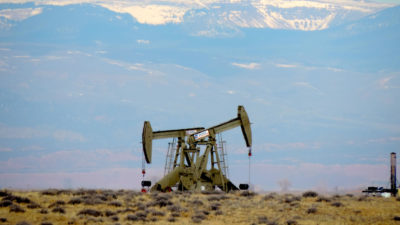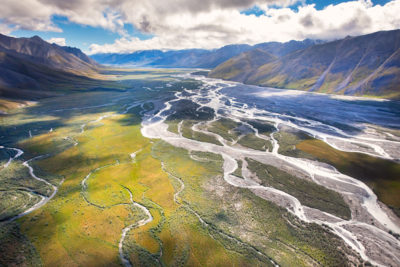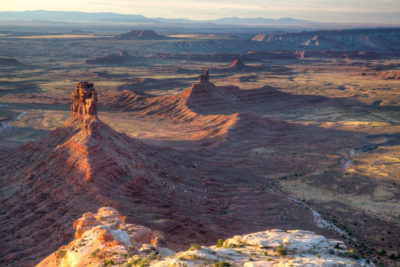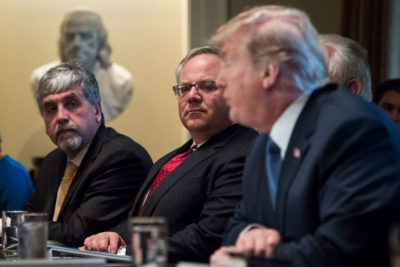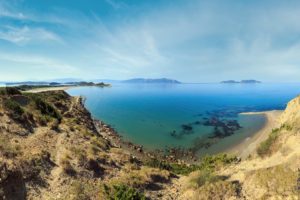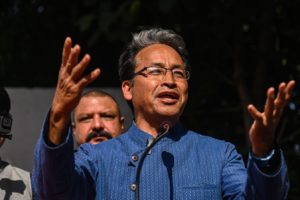In 2017, Congressman Jason Chaffetz of Utah lit the fuse of what many Republicans in Western states hoped would be a new effort to take over control of federal lands, and introduced a bill to sell some 3.3 million public land acres out of federal hands.
The backlash – this time from sportsmen and the outdoor recreation community, as well as environmentalists – was immediate and intense. Chaffetz soon withdrew the legislation.
The open effort in Congress to wrest public lands away from the federal government and transfer them to states or private owners may seem to have subsided. But it has simply gone underground. There is a stealth battle to whittle away at federal authority over public lands that is very much in motion, as the Trump administration aggressively advances an agenda to remake U.S. policies toward those lands.
“There’s a quiet, almost covert, effort to dismantle the public lands management infrastructure,” said Jim Lyons, who was Deputy Assistant Secretary for Land and Minerals Management at the Interior Department in the Obama administration. “It’s very effective. I call it evil genius.”
The Trump administration is responsible for the largest reduction in protected public lands in history, a study finds.
Former Trump adviser Steve Bannon coined the term “deconstruction of the administrative state,” to describe efforts to take power away from the federal government and allow business a freer hand in development. Nowhere is that policy being carried out more systematically than in the Trump administration’s actions on public lands, where the businesses seeking that freer hand are primarily the oil and gas extraction, logging, and mining industries.
There are hundreds of millions of acres of publically owned lands across the West and Alaska, including National Forests, Bureau of Land Management lands, National Parks and National Monuments. They include some of the nation’s most iconic landscapes, and they are also critical to state and local economies. As a percentage of each Western state, federal ownership ranges from 29 percent of Montana to 79 percent of Nevada.
According to a study in the journal Science, the Trump administration is responsible for the largest reduction of protected public lands in history. Three months after taking office, Trump issued an executive order that led to dramatic reductions in the size of two national monuments in Utah — Bears Ears National Monument, shrunk by 85 percent, and Grand Staircase-Escalante National Monument, shrunk by 51 percent.
In 2017, the Republican-led Congress voted to open the Arctic National Wildlife Refuge to oil and gas development for the first time. Last month, the Interior Department announced its final plan for exploration and development in this pristine wilderness, keeping the department on track to auction leases for the rights to drill in the refuge’s coastal plan before the end of this year.
The Arctic National Wildlife Refuge in Alaska. The Interior Department is on track to begin auctioning leases to drill for oil and gas in the refuge by the end of this year. Lisa Hupp/USFWS
Under the Trump administration, issues thought long settled have been opened up again for rollback. The Obama administration, for example, had decided against renewing two expired leases owned by a Chilean mining company near the 365-square-mile Boundary Waters Canoe Area Wilderness in Minnesota and ordered a study of possible impacts a proposed copper and nickel mine could have on the natural area with a eye toward imposing a 20-year ban. The Trump administration reinstated the leases last year and ended the study.
This summer, EPA administrators told staff that the agency would no longer oppose the Pebble Mine, in Bristol Bay, Alaska, a massive copper and gold mine that would, scientists had determined, likely have “significant and irreversible” effects on the salmon fishery in the bay.
President Trump’s vaunted wall along the U.S.-Mexico border will also impact large areas of public lands. One of the first places for construction of the 30-foot high barrier, part of Trump’s diversion of $3.6 billion in military construction projects, is in Organ Pipe Cactus National Monument in southern Arizona, federally protected as wilderness and designated an international biosphere reserve. All told the new border fence will be built along 175 miles of desert, and 44 of those miles will be built in federally protected areas. Environmentalists say the fence will block migratory species.
Leasing of public lands for oil and gas is accelerating across the West, as companies lock up tracts of federal land.
All along the border through New Mexico and Arizona are biologically diverse areas on public lands that depend on a connection between wildlands in the U.S. and Mexico. Endangered Mexican gray wolves in the two countries, for example, “have a low degree of genetic diversity and for them to survive, the two populations need to interbreed,” said Kevin Bixby, executive director of the Southwest Environmental Center in Las Cruces, New Mexico. “With a bollard wall, anything with a skull size of more than 4 inches can’t get through.” That means that deer, javelinas, wolves, and jaguars, which are known to enter the U.S. from Mexico, are blocked at the border.
The Trump administration is considering revisions to what is known as the Roadless Rule, a conservation initiative of the Clinton administration. Some 58 million acres of roadless land in the nation’s national forests, possibly eligible for wilderness designation someday, were protected from development under this rule so as not to spoil the wilderness qualities until a decision on long-term protection could be made. Included in that protection were 9.5 million acres of the Tongass National Forest, in southeastern Alaska, which is the nation’s largest national forest. But according to The Washington Post, Trump has instructed Agriculture Secretary Sonny Perdue to write new roadless rules that would eliminate the Clinton-era protections to allow logging, mining, and energy development.
Leasing of public lands for oil and gas is accelerating across the West. Companies are locking up tracts of federal land for 10 years while paying minimal fees. “We’re going to have repercussions about these decisions for decades to come,” said Jayson O’Neill, of the Western Values Project, a conservation nonprofit focused on public lands.
“The pace at which they are doing this is by design,” said Lyons. “Nobody can keep up.”
The Valley of the Gods in southeastern Utah, which lost protections when President Trump dramatically reduced the size of Bears Ears National Monument. Bob Wick/BLM
Trump has eliminated budget allocations for the Land and Water Conservation Fund, which is funded by the leasing of public oil and gas reserves to energy companies and uses the money to buy acreage for parks and wilderness and for federal land maintenance and infrastructure. “It doesn’t cost taxpayers a dime,” said O’Neill. “Time and again the Trump administration has zeroed out funding for this critical fund.”
Protection for wildlife species has also been especially hard hit by the Trump administration. During the August congressional recess, the Interior Department promulgated a new rule that would fundamentally change the Endangered Species Act — allowing economic information to be considered in addition to science in decisions to list a species, changing the rule that automatically extends protections to threatened species as their status is being considered, and limiting the role of climate change in consideration of listing. Habitat where an endangered species might move to as the climate warms can no longer be protected.
The imperiled sage grouse, which makes its home in the vast sagebrush sea that covers millions of acres across 11 Western states, has come under particular focus of the Trump administration in order to facilitate oil and gas leasing. As Assistant Secretary for Lands and Minerals, Lyons was instrumental in plans, developed together with states and private landowners, to protect the bird in a way that would avoid an endangered species listing. This strategy was written into BLM plans.
New plans however, written at the direction of the Trump administration, have eliminated many of the protections for the birds and allow oil and gas development in important habitat. “They are summarily going through and removing most, if not all of them from existing plans,” Lyons said. “They have reduced the amount of protected habitat and are accelerating leasing in places that were off limits.”
“It’s like Humpty Dumpty, and it will take a long time to put the pieces back together,” said a critic of the administration’s lands policies.
These changes are not surprising given the cast of Trump administration officials assembled to remake the land management agencies.
The acting director of the Bureau of Land Management is William Perry Pendley, who has long campaigned against federal control of public lands as president of the Mountain States Legal Foundation and who once wrote an article for National Review in 2016 entitled “The Federal Government Should Follow the Constitution and Sell Its Western Lands.”
Karen Budd-Fallen, a Wyoming property rights attorney and longtime critic of federal public lands management, has been named Deputy Solicitor for Parks and Wildlife at the Interior Department. Aurelia Skipwith, who lobbied for Monsanto, has been nominated to run the U.S. Fish and Wildlife Service.
Interior Secretary David Bernhardt himself was most recently an industry lobbyist with Brownstein Hyatt Farber Schreck, representing such clients as Rosemont Copper Mine, Halliburton Energy Services, and the Independent Petroleum Association of America — all of which are active in development on public lands.
Interior Secretary David Bernhardt, center, was previously a lobbyist for extractive industries active on public lands. Jabin Botsford/The Washington Post via Getty Images
There have been numerous questions raised about Bernhardt’s apparent conflicts of interest. According to a report by the Western Values Project, 20 of Bernhardt’s former clients have lobbied Interior during his initial recusal period. He is now refusing to renew the recusal, telling Congress in testimony aired by CSPAN, “I am basically handcuffed and not in the game for the American people if I am recusing myself. I am actually pretty good at going up against these guys, and I don’t have any problem with doing that. I would say you want your A quarterback playing for your team.”
Bernhardt knows this terrain. He has held several senior positions with the Interior Department, including in 2006 as the department’s Solicitor. “He knows how things work,” said Lyons. “Bernhardt is the most dangerous person in the administration because he’s so adept. He’s really good and really effective.”
The administration is moving hundreds of high-level BLM staffers out of Washington, D.C., to the West, including to Reno, Nevada, and Grand Junction, Colorado, so, officials have said, they can be closer to the lands they manage. The administration is keeping Congress in the dark about details of the move. U.S. Senator Tom Udall, Democrat of New Mexico, and Representative Betty McCollum, Democrat of Minnesota, wrote a letter in August to the Assistant Secretary for Land and Minerals Management objecting to the move: “We are concerned that the proposal is designed to reduce the Bureau’s effectiveness and relevance.” Many BLM employees are being offered lower-level jobs and lower pay, according to The Washington Post, “…confirming suspicions that the real purpose is to drive experts out of government and thereby shrink the agency.”
“They are remarkably effective,” Lyons said of the administration’s public lands team. “It’s like Humpty Dumpty, and it will take a long time to put the pieces back together. It will set conservation back a generation or two.”
